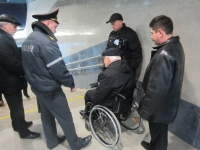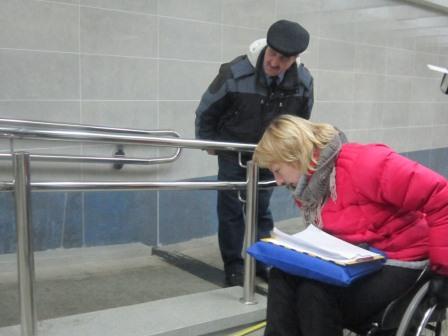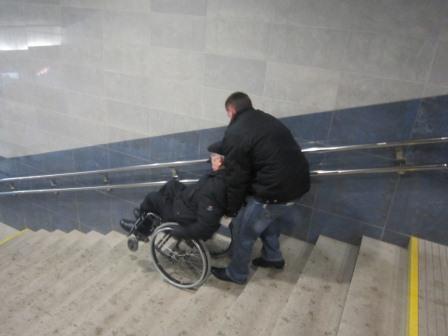
On December 7 participants of the project “Barrier-free environment monitoring” ran tests of the instrument for monitoring the accessibility of architectural objects. This time they tested new station of Minsk subway “Petrovschina” and movie theatre “Berest’e”. Because of the weather conditions the participant didn’t manage to test the ground route between the two objects, the snow had changed their planes.

Members of coalition “Accessibility”, representatives of “Belarusian society of deaf”, specialists in barrier-free environment of “Minskmetrostroi” and “Minsk subway”, journalists of Minsk mass-media took part in the monitoring.

Administration of “Minsk subway” understood the need of such project and gave permission to make pictures and to measure and helped to run the tests by providing access to many objects of the subway station. But even such preparation hadn’t helped the participants couldn’t even get to the subway. There was an elevator but it didn’t work. There is still no ramp for disabled to get to the “Petrovschina” station. “Taking into account the fact that we didn’t even manage to get to the subway we can say that station “Petrovschina” is inaccessible for persons with disabilities – comments the situation the manager of the project “Barrier-free environment monitoring” Galina Krot. We should admit that there are many universal design appliances such as elevator, special signs, ramps and handrails. But the impossibility to get there is a huge minus. A person simply cannot use other appliances. Subway employees offered us to help in getting there. “We will carry you down. Our employees underwent special training – said the head of subway’s movement department Grigoriy Iakimkov. – You have to ask a ticket collector and we will carry you down and help to get into a train, call the train dispatcher in order to organize the meeting at the station you want. There you will be carried out of the subway”. But the subway employees didn’t undergo the training in moving persons with disabilities. Vladimir Potapenko, the head of “Belarusian society of disabled”, asked his assistant to show how it is done properly. But this is not a solution of the problem. For example, a disabled came up to the entrance of subway and it is still a long a way to ticket collector, how he is supposed to ask for help in this case…

The monitoring participants went down to the platform. The height from the platform to the floor of a car is 12 centimeters instead of 5 in accordance with the norms. And again we can see limitations for a person in wheelchair. “But Grigoriy Iakimkov says that 12 centimeters is in the frames of the norm and if there are more people in the car it will subside and the height will become less than 12 centimeters”. “And of course subway employees will help you to get into the car!” – subway administration ensures us.

Movie theatre “Berest’e” is the next monitoring object. “The first thing you see that there are no visual signs for persons with disabilities and it is very difficult for such persons to understand that entrance for disabled is at the back of the building – says a participant of the project Taiana Kryshtal. – Then we see violations of door group. The doors do not correspond with the norms – a wheelchair-bound disabled wouldn’t be able to enter by himself. Toilet is situated in the basement and you can’t get there even with the help of 4 persons that was offered to us in subway! Ticket office windows are situated too high”. Galina Krot said: “In accordance with the international standards if in a building there is something inaccessible for disabled persons the whole object is considered to be inaccessible. After having spent two hours in “field” we can say that cultural leisure is not for disabled yet. We will not be able to enter the movie theatre, more over we will not be able even to get there by subway. What concerns the monitoring instrument we will continue to work on it, taking into account the experience we got today. Unfortunately, because we don’t have some special appliances we cannot completely test the instrument”.
We remind that the realization of the project “Barrier-free environment monitoring” has started in July 2012. The project is aimed at the creation of barrier-free environment monitoring instrument and its usage. In the frames of the project coalition “Accessibility” and invited experts are holding analyses of existing and used barrier-free environment monitoring instruments and will prepare “Handbook for holding monitoring of barrier-free environment”. They will hold pilot using of monitoring instrument and present the results to public.





